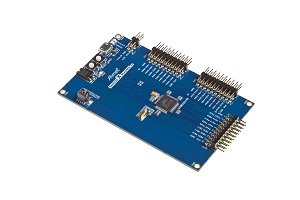SAM D20 Xplained Pro Evaluation Kit¶
Overview¶
The SAM D20 Xplained Pro evaluation kit is ideal for evaluation and prototyping with the SAM D20 Cortex®-M0+ processor-based microcontrollers. The kit includes Atmel’s Embedded Debugger (EDBG), which provides a full debug interface without the need for additional hardware.

Hardware¶
- ATSAMD20J18 ARM Cortex-M0+ processor at 48 MHz
- 32.768 kHz crystal oscillator
- 256 KiB flash memory and 32 KiB of RAM
- One yellow user LED
- One mechanical user push button
- One reset button
- On-board USB based EDBG unit with serial console
Supported Features¶
The atsamd20_xpro board configuration supports the following hardware features:
| Interface | Controller | Driver/Component |
|---|---|---|
| NVIC | on-chip | nested vector interrupt controller |
| Flash | on-chip | Can be used with NFFS to store files |
| SYSTICK | on-chip | systick |
| WDT | on-chip | Watchdog |
| GPIO | on-chip | I/O ports |
| USART | on-chip | Serial ports |
| SPI | on-chip | Serial Peripheral Interface ports |
Other hardware features are not currently supported by Zephyr.
The default configuration can be found in the Kconfig
boards/arm/atsamd20_xpro/atsamd20_xpro_defconfig.
Connections and IOs¶
The Microchip website [1] has detailed information about board connections. Download the SAM D20 Xplained Pro Schematic [2] for more detail.
System Clock¶
The SAMD20 MCU is configured to use the 32.768 kHz external oscillator with the on-chip PLL generating the 48 MHz system clock.
Serial Port¶
The SAMD20 MCU has 6 SERCOM based USARTs. One of the USARTs (SERCOM3) is connected to the onboard Atmel Embedded Debugger (EDBG). SERCOM4 is available on the EXT1 connector.
SPI Port¶
The SAMD20 MCU has 6 SERCOM based SPIs. On the SAM D20 Xplained Pro, SERCOM0 is available on the EXT1 connector.
Programming and Debugging¶
The SAM D20 Xplained Pro comes with a Atmel Embedded Debugger (EDBG). This provides a debug interface to the SAMD20 chip and is supported by OpenOCD.
Flashing¶
Build the Zephyr kernel and the Hello World sample application:
# On Linux/macOS cd $ZEPHYR_BASE/samples/hello_world mkdir build && cd build # On Windows cd %ZEPHYR_BASE%\samples\hello_world mkdir build & cd build cmake -GNinja -DBOARD=atsamd20_xpro .. ninja
Connect the SAM D20 Xplained Pro to your host computer using the USB debug port.
Run your favorite terminal program to listen for output. Under Linux the terminal should be
/dev/ttyACM0. For example:$ minicom -D /dev/ttyACM0 -oThe -o option tells minicom not to send the modem initialization string. Connection should be configured as follows:
- Speed: 115200
- Data: 8 bits
- Parity: None
- Stop bits: 1
To flash an image:
# On Linux/macOS cd $ZEPHYR_BASE/samples/hello_world mkdir build && cd build # On Windows cd %ZEPHYR_BASE%\samples\hello_world mkdir build & cd build cmake -GNinja -DBOARD=atsamd20_xpro .. ninja flash
You should see “Hello World! arm” in your terminal.